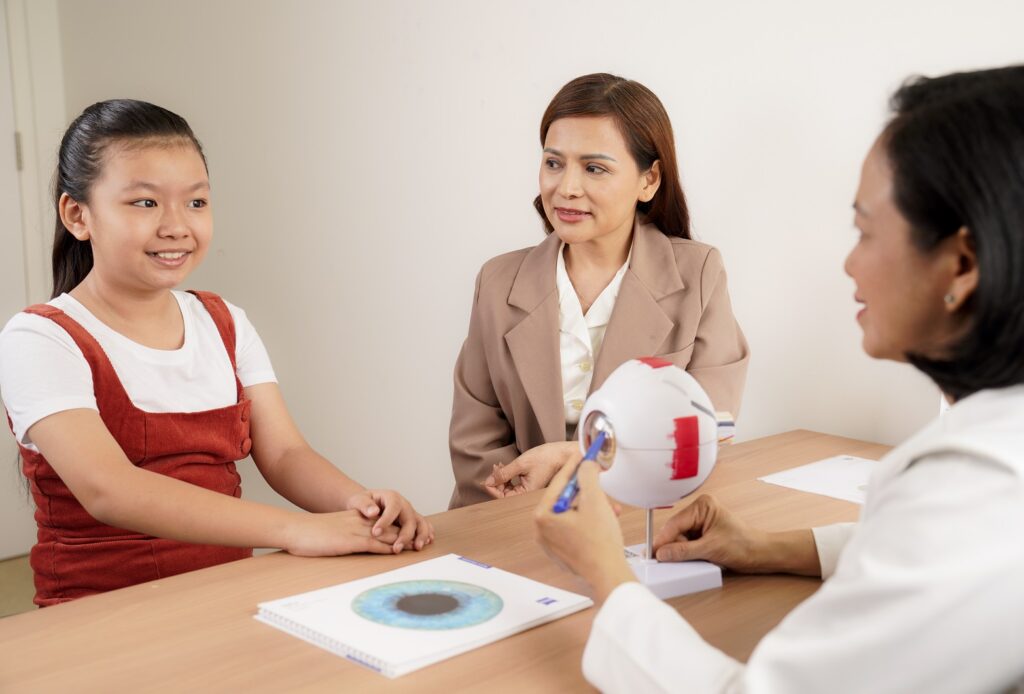
Prima Medical Center Saigon, Pediatric Ophthalmology & Ortho K
How long on digital devices screen for children is recommended?
18 February, 2024
Prima Saigon Eye Hospital :The use of digital devices for learning, homework, and leisure can take many forms, such as portable laptops, tablets, and smartphones. Research shows that screen time can be beneficial for children when balanced with other non-screen activities.

Prima Saigon Eye Hospital: Myopia is an eye disease that causes blurred distance vision, also called nearsightedness.
Spending too much time in front of a screen is a cause for concern for parents, as excessive screen use can affect the development of good vision as well as physical and mental health. Children exposed to screens before the age of three are more likely to develop myopia in preschool age.
Myopia is an eye disease that causes blurred distance vision, also called nearsightedness.Once children develop myopia, it usually gets worse every few months or even several months. When it comes to healthy vision development, the challenge with screens will likely be the length of use and distance from the face. Digital devices such as cell phones and tablets are typically held closer to the eyes than a book.
The mechanism is not yet entirely clear, but further research has shown that increased use of digital devices actually leads to greater myopia in children, even more so when combined with computer use.
How much time should children use digital devices per day?
A 2011 study published in the Journal of Pediatrics found that 47% of children spend more than two hours a day in front of screens for entertainment purposes and in 2019 that number increased to 98% in the United States.
Recent research has shown that children aged 6 to 10 spent more free time in front of screens during the COVID-19 lockdown than any other age group, with consequences for diet, mental health, eye health and physical activity.
A report from early 2022 shows that children aged 8 to 12 now spend 5.5 hours a day in front of a television screen, compared to an average of 4 hours and 44 minutes a day in 2019.
How much screen time is it recommended from WHO?
The World Health Organization has published detailed recommendations on screen time for children under 4, as well as guidelines on physical activity and sleep.
Guidelines have been developed for physical activity for children ages 5 and older and for adults, but not for screen time. For school-age children, this recommendation becomes even more complex as screens are increasingly used in formal education settings.This means that it is important to limit screen time to entertainment only.
When families pay attention to media consumption at home and parents monitor their children’s access to digital technologies, screen time decreases and sleep quality and academic performance improve.
The Australian Department of Health and the American Academy of Pediatrics have recommended limiting sedentary behavior and screen time outside of school hours to 2 hours per day.
Screen time can promote sedentary (immobile) behavior, which can have numerous effects on children’s physical and mental health.
The World Health Organization recommends the following physical activity guidelines for children aged 5 to 17 years:At least 60 minutes per day on average of moderate to vigorous physical activity, primarily aerobic, throughout the week.
Including vigorous aerobic and muscle training sessions. Bone-building and bone-strengthening activities, at least 3 days per week.Limit the time you spend sitting, including time spent in front of a screen for recreational purposes.
Improving the quality of screen time
Research shows that watching content on your child’s screen together can have positive benefits. This leads to “active mediation” of the digital media to which children are exposed and provides opportunities to spend time in front of a screen in a way that contributes to social and linguistic development.
Examples of watching together:
- Watch a television program with your child and talk about what you are watching, sing together or ask your child to repeat words or content out loud.
- Shared screen time, including playing games or creating interactions.
- Further discussion. in terms of content.
From an eye health perspective, viewing content on a television screen rather than a tablet or smaller digital device reduces strain on the visual system. It can also make it easier for parents to monitor digital content, making it easier to watch remotely and listen to during other activities.
Video chats are another example of “quality” screen time that can help build relationships and improve language skills. This is an exception to the rule of recommendations limiting the time of use of the device in infants and young children.

Dr Thao Vo, Chief Medical Officer of Prima Saigon Eye Hospital is consulting a young patient.
Parents may feel less able to monitor screen content as their children get older, but this is especially important with younger children. A study found that children ages 5 to 8 were unable to recognize potential dangers in online content and adopt safe online behavior.
Three rules for screen time
Research points to the value of open family discussion on digital media usage, including setting time- and activity-related goals.When it comes to eye health and reducing the risks of myopia, there are three simple rules which you can teach your children on screen time.
- The elbow rule. This is where your child should try to keep an elbow-to-wrist distance between anything they are viewing up close, and their eyes. Try it yourself, and show them at home – make a fist, put it next to your eyes, and where your elbow sits is the closest any screen or book should get to your eyes when reading. This helps to avoid very close viewing distances (less than 20cm) which are associated with increased visual effort and development of myopia.
- The 20/20 rule. This is where your child aims to take a break from reading every 20 minutes, for 20 seconds. He or she should look across the room for those 20 seconds, to relax the focussing muscles in the eyes before recommencing reading or screen time. This is to avoid prolonged time spent in close-up vision – more than 45 minutes without a break has been linked to myopia.
- The two-hour rule. This is limiting leisure or recreational screen time, outside of school work, to less than 2 hours per day.
Dr THAO Vo, Chief Medical Officer , Prima Saigon Eye Hospital
Our Ophthalmology Care Team
- Dr THAO Vo, Chief Medical Officer , Prima Saigon Eye Hospital
- Dr AN Trinh, Head of General Ophthalmology
- Dr BINH Tran, Senior Consultant
- Dr TRAN Nguyen, Consultant
If you need an eye assessment, please have a visit to Prima Saigon Eye Hospital
- Address: 27 Ky Dong St, District 3, HCMC
- Website: https://primahealth.vn/en/
- Business Hours: 07:30 – 17:00 from Monday – Saturday
- HOTLINE: 0919-209-039 or 1900 – 9115
Prima Saigon Eye Hospital recommends that clients should reserve their intended consultation at least three days before their visit for convenience and less waiting time.
Prima Saigon Eye Hospital :The use of digital devices for learning, homework, and leisure can take many forms, such as portable laptops, tablets, and smartphones. Research shows that screen time can be beneficial for children when balanced with other non-screen activities.

Prima Saigon Eye Hospital: Myopia is an eye disease that causes blurred distance vision, also called nearsightedness.
Spending too much time in front of a screen is a cause for concern for parents, as excessive screen use can affect the development of good vision as well as physical and mental health. Children exposed to screens before the age of three are more likely to develop myopia in preschool age.
Myopia is an eye disease that causes blurred distance vision, also called nearsightedness.Once children develop myopia, it usually gets worse every few months or even several months. When it comes to healthy vision development, the challenge with screens will likely be the length of use and distance from the face. Digital devices such as cell phones and tablets are typically held closer to the eyes than a book.
The mechanism is not yet entirely clear, but further research has shown that increased use of digital devices actually leads to greater myopia in children, even more so when combined with computer use.
How much time should children use digital devices per day?
A 2011 study published in the Journal of Pediatrics found that 47% of children spend more than two hours a day in front of screens for entertainment purposes and in 2019 that number increased to 98% in the United States.
Recent research has shown that children aged 6 to 10 spent more free time in front of screens during the COVID-19 lockdown than any other age group, with consequences for diet, mental health, eye health and physical activity.
A report from early 2022 shows that children aged 8 to 12 now spend 5.5 hours a day in front of a television screen, compared to an average of 4 hours and 44 minutes a day in 2019.
How much screen time is it recommended from WHO?
The World Health Organization has published detailed recommendations on screen time for children under 4, as well as guidelines on physical activity and sleep.
Guidelines have been developed for physical activity for children ages 5 and older and for adults, but not for screen time. For school-age children, this recommendation becomes even more complex as screens are increasingly used in formal education settings.This means that it is important to limit screen time to entertainment only.
When families pay attention to media consumption at home and parents monitor their children’s access to digital technologies, screen time decreases and sleep quality and academic performance improve.
The Australian Department of Health and the American Academy of Pediatrics have recommended limiting sedentary behavior and screen time outside of school hours to 2 hours per day.
Screen time can promote sedentary (immobile) behavior, which can have numerous effects on children’s physical and mental health.
The World Health Organization recommends the following physical activity guidelines for children aged 5 to 17 years:At least 60 minutes per day on average of moderate to vigorous physical activity, primarily aerobic, throughout the week.
Including vigorous aerobic and muscle training sessions. Bone-building and bone-strengthening activities, at least 3 days per week.Limit the time you spend sitting, including time spent in front of a screen for recreational purposes.
Improving the quality of screen time
Research shows that watching content on your child’s screen together can have positive benefits. This leads to “active mediation” of the digital media to which children are exposed and provides opportunities to spend time in front of a screen in a way that contributes to social and linguistic development.
Examples of watching together:
- Watch a television program with your child and talk about what you are watching, sing together or ask your child to repeat words or content out loud.
- Shared screen time, including playing games or creating interactions.
- Further discussion. in terms of content.
From an eye health perspective, viewing content on a television screen rather than a tablet or smaller digital device reduces strain on the visual system. It can also make it easier for parents to monitor digital content, making it easier to watch remotely and listen to during other activities.
Video chats are another example of “quality” screen time that can help build relationships and improve language skills. This is an exception to the rule of recommendations limiting the time of use of the device in infants and young children.

Dr Thao Vo, Chief Medical Officer of Prima Saigon Eye Hospital is consulting a young patient.
Parents may feel less able to monitor screen content as their children get older, but this is especially important with younger children. A study found that children ages 5 to 8 were unable to recognize potential dangers in online content and adopt safe online behavior.
Three rules for screen time
Research points to the value of open family discussion on digital media usage, including setting time- and activity-related goals.When it comes to eye health and reducing the risks of myopia, there are three simple rules which you can teach your children on screen time.
- The elbow rule. This is where your child should try to keep an elbow-to-wrist distance between anything they are viewing up close, and their eyes. Try it yourself, and show them at home – make a fist, put it next to your eyes, and where your elbow sits is the closest any screen or book should get to your eyes when reading. This helps to avoid very close viewing distances (less than 20cm) which are associated with increased visual effort and development of myopia.
- The 20/20 rule. This is where your child aims to take a break from reading every 20 minutes, for 20 seconds. He or she should look across the room for those 20 seconds, to relax the focussing muscles in the eyes before recommencing reading or screen time. This is to avoid prolonged time spent in close-up vision – more than 45 minutes without a break has been linked to myopia.
- The two-hour rule. This is limiting leisure or recreational screen time, outside of school work, to less than 2 hours per day.
Dr THAO Vo, Chief Medical Officer , Prima Saigon Eye Hospital
Our Ophthalmology Care Team
- Dr THAO Vo, Chief Medical Officer , Prima Saigon Eye Hospital
- Dr AN Trinh, Head of General Ophthalmology
- Dr BINH Tran, Senior Consultant
- Dr TRAN Nguyen, Consultant
If you need an eye assessment, please have a visit to Prima Saigon Eye Hospital
- Address: 27 Ky Dong St, District 3, HCMC
- Website: https://primahealth.vn/en/
- Business Hours: 07:30 – 17:00 from Monday – Saturday
- HOTLINE: 0919-209-039 or 1900 – 9115
Prima Saigon Eye Hospital recommends that clients should reserve their intended consultation at least three days before their visit for convenience and less waiting time.



